This is, for now, the official version of the project space design.
The space is a mixture of installation and stage, where the audience is invited to leave their daily perception of time and space when entering this surreal and supra-humane universe.
Participants have an individual experience, even being not alone in the space. In the entrance, they are given headphones that will give them a sense of 1:1 experience. The audio being transmitted via headphones is a big part of the performance and will be mentioned a few times throughout this report.
The performance is a non linear narrative, not literal and not theatrical in the sense of pretending to be a character, but instead putting the performer’s body into situations that would explicitly investigate the topics of the work. The performance is short (max 40 Minutes) and keeps repeating itself for as many hours as possible, until the weight of time causes complete exhaustion of the performer. The whole experience is separated in three blocks, each hosting one scene with a different structure, but in the same space, that changes throughout the narrative.
After receiving the headphones, groups of people are guided into the first block. Each time the performance can host a set number of participants, each group experimenting a different version of the performance. The audience can come back in a different time to experiment the performance in another state, after the passing of hours.
Block one – coffee seeds for a neutral mind
The first block is a smooth transition from the “real” world to this universe. I write real in quotation marks because the intention of this space is exactly to expand the notion of reality, in a way that does not assume that what’s digital is less real than what is physical – and also, that if the notion of reality is attached to the sense of sight, touch, smell and taste, it’s irrelevant to use this term. What I propose is to see the world sensorially, and investigate the possibilities for the notion of reality independently of being based on our five senses. I invite the audience to investigate it boldly, without having to get attached to senses to have some sort of security, but rather trusting the space and expanding this understanding by trusting a performative persona that guides them through this journey.
For that, I suggest a smooth introduction. A space of transition that delicately brings their senses to a point zero, a place of start, as if when we smell coffee seeds in between smelling perfumes at store, to prepare the body for what is about to come next. The brief introduction is intentionally an illustrative space, a tunnel-like platform with gradually lower lights, and shinning elements around the person for them to feel they are being guided and can trust the walk inside the installation. It has a translucent handrail with light inside, which in the end of the catwalk reduces into only light, as illustrated. The space is silent in the beginning, and throughout the introduction a neutral sound plays, gradually being louder, but never too loud that it is uncomfortable. This sound will keep playing until the end of the journey.
In the end of this walk, the participant enters a bigger space, still walking in a set path on the floor but without the handrail. The space has fog in it. At this point, I expect to have guided the audience into a neutral state of mind, in which they feel ready and curious for the next steps.
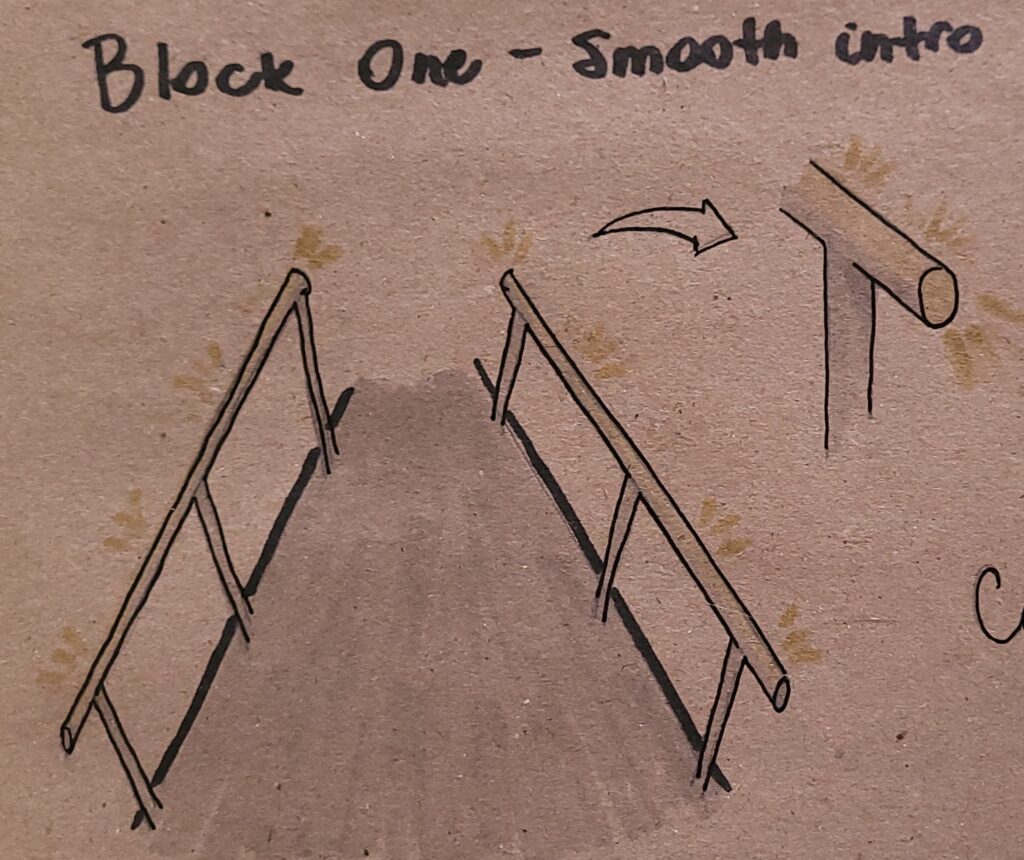
Example of walkway to reach the bigger space. Floor with familiar materiality, simple and translucent railway with light.
The path in which they are walking on is now defined by a “wall of light” on what were the side walls of the tunnel. These are simply sharp LED lights on the ceiling and floor forming a line, and when turned on, creates a relation to the fog forming what seems like walls.
Now, the audience is challenged to question how the approach of this conversation between performer and them is going to happen. I imagine this would be a good point for them to be presented to the performer, the performance itself, or any persona that will be used to communicate content to them. I think a dream-like video could be a nice fist talk between the parts, and imagine that in order for them to have the first perception that they will be invited to fully dive into this universe, they should have their senses put into action.
So, in addition to the walls of lights, there is a screen in front of them. There, a video is played and it moved in the rhythm the persons walk. Following the structure of the last block, the participants would have a set space to walk, a guiding trail on the floor. The reason for this is purely technical – if there is a small space cut off from the screen, and it is the exact same size of the trail for the audience to walk on, I could play with materiality on their feet. I am a big enthusiast of exploring the sense of touch through other parts of the body that are not the hands, because I think it is often forgotten how sensible our skin is in the whole body. As the screen moves, in the pace of the participants’ walk, some of the same materials that are shown on the video could be presented on the floor, so that, apart from being immersed on the content being shown, they also have a gradual sense of participation as they feel these textures on the physical space they are in.
This tracking is done using the Isadora Software, by Troikatronix. It is a graphic programming platform that allows users to visually relate technological resources to the scene. Using a simple tracking camera, it is possible to create a patch that will allow the participants motion to the movement of the screen. In other words: if the participants walks in a direction, the screen moves in the same direction. If the person stops, the screen stops. The patch is a shortcut used to connect the body of the participant and the “body” of the screen. On top of the screen, the motion camera is fixed so that it is constantly tracking the person. The camera is connected to a computer running Isadora. The computer is also connected to a motor, similar to the ones used to retract ropes, that makes the screen be pulled back following the movements of the person. As the person moves forward, they get in contact with different floor textures.
The cameras used for this can be:
– Microsoft Kinect for Xbox 360 (Model 1414 or 1473 Kinect)
– Orbbec Astra Pro and Astra Mini
– Intel Realsense D435
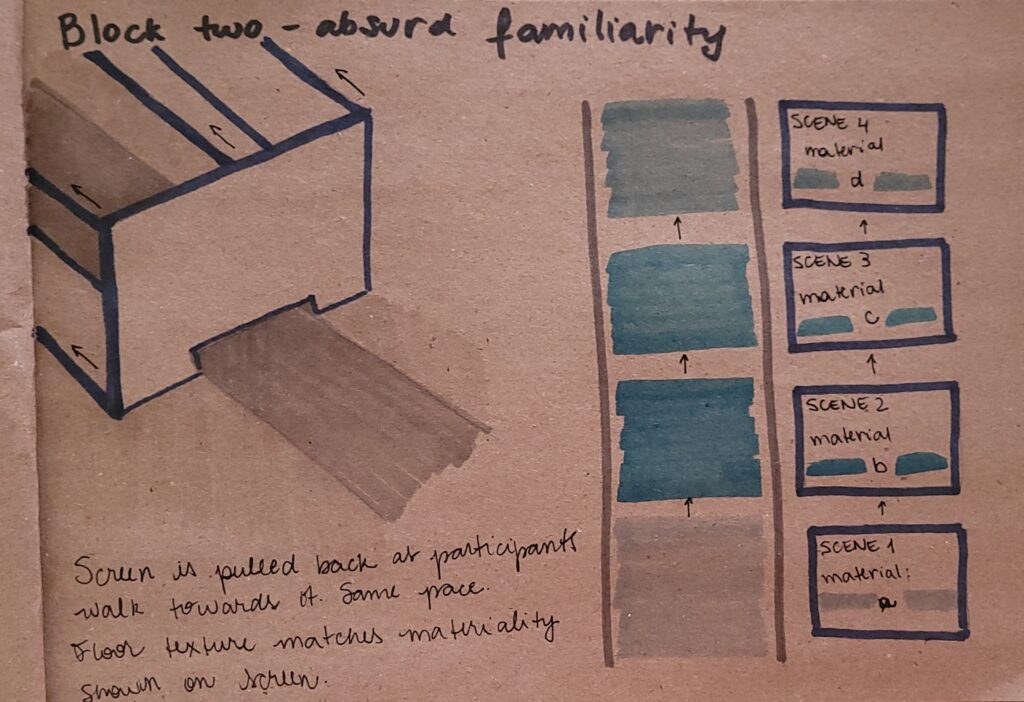
As for content, I imagine it to be a short story-like video that shows sensations and feeling by putting the body in relation to materiality. It shouldn’t be a story as in beginning, climax and end, but rather just a sequence of climaxes. The challenge is to think how to put it in a video that doesn’t feel overwhelming or kind of attacking the participant, since it’s the first content part they will get in touch with. As they walk, they would feel the same materials passing through their feet and lower legs. The movements shown on video should be of a body putting itself in bold situations, with no editing of any kind, but explicating how absurd this body-material could look like, and which weird looking creatures and expanded bodies can emerge.
Then, in order to slowly transition to 3D digital and physical absurdity, there is a “physical” introduction between audience and performer. For that, the video turns off and the screen turns up to be translucent, and since it is placed on the way between both, that gives the audience the sensation that the happening on the other side is purely virtual, when it is actually a live performer acting now. Whatever the performer is doing, it should also be an extreme short performance to intensify this sensation of doubt. In the end of the action, the performer tells the participants to look around, and the walls of light are turned off – suddenly, the audience realize they have been in an enormous space for the past minutes, even if they only noticed the screen in front of them.
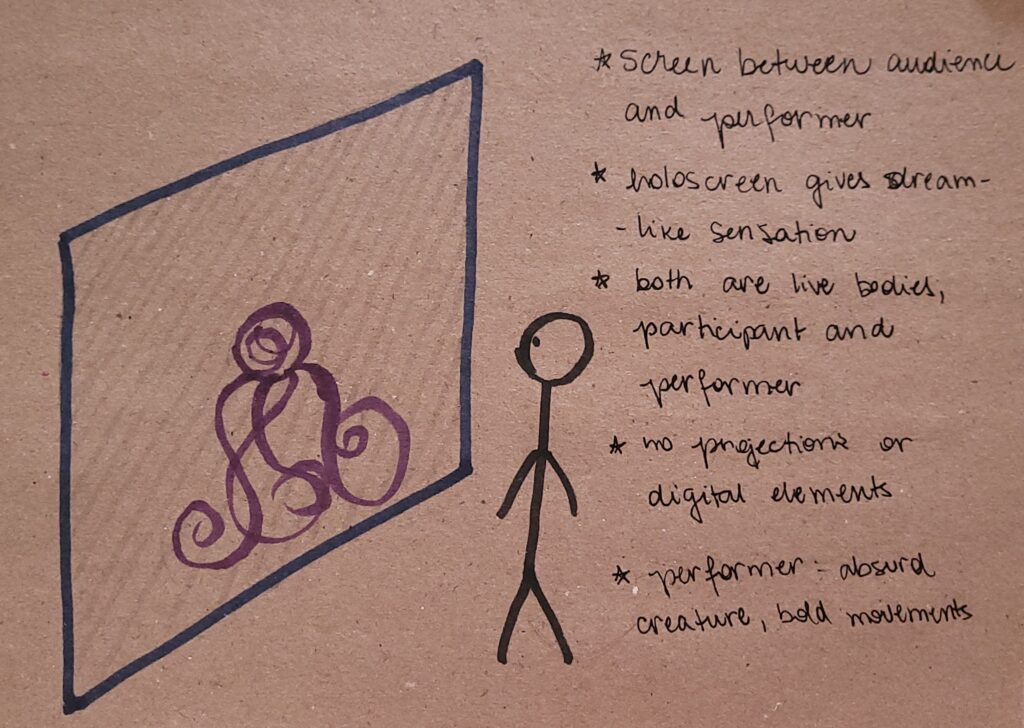
The room has several screens similar to this first one, all translucent and going from the floor to the high ceiling. The space has several dunes made of small glass beads, and the audience could walk in between them. The intention is to have a dream-like space, so that the audience would already be sufficiently familiarized with absurd settings, and wouldn’t understand the space as an illustrative story-telling, but rather a strange, magical space they could use as an “anchor” to be able to relate to the performer – a safe place where they would be more comfortable watching the persona dive into the unknown.
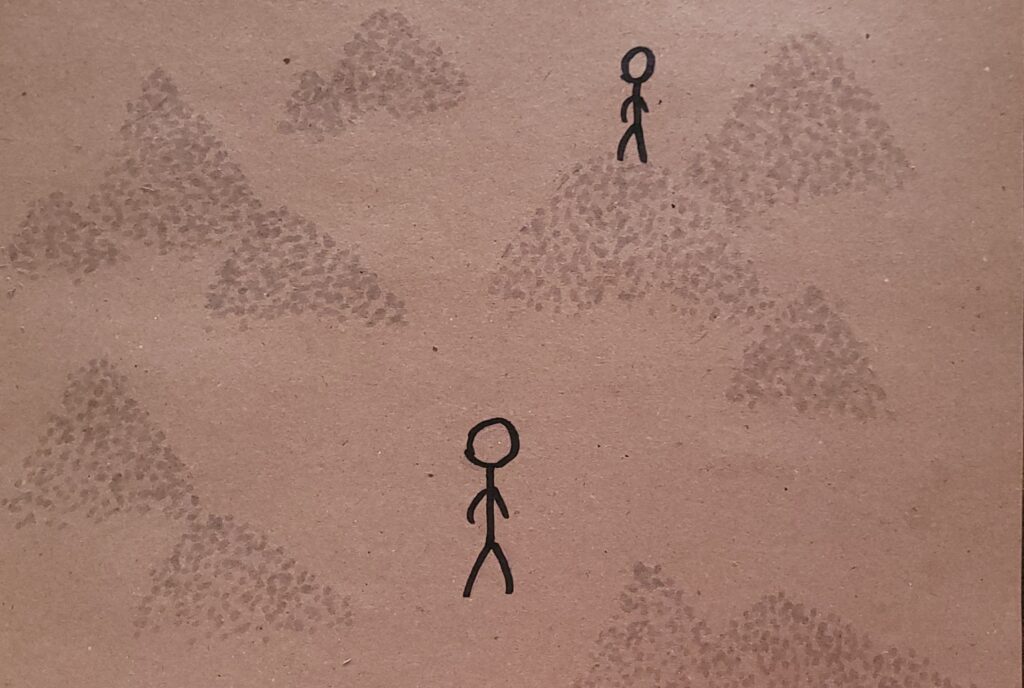
Each participant is guided to a specific point in space through one digital element that is projected on their feet, and walks them to each seat. Imagine this element being something like a laser point that walks them to their seat. This is done using mapped projection, also through the Isadora Software by Troikatronix. Each person seats alone, between the dunes and screens, and cannot see the other participants. All of them have a perfect view of the main screen, the first one they got in contact with, which will be important throughout the experience.
The seats are distributed on the space based on three basic principles:
– Participants can’t see each other;
– Each participant has one holographic screen in front of them;
– All participants are in the light of sight of the main screen, which is also holographic.
As an example, see drawing number one. It shows the line of sight (in orange) and positioning of each seat (in purple) so that all can see the main screen (in grey, in the center).
When positioned, the seats should look like drawing number two, to be completed on both sides. On the side that already has the complete representation, you can see the audience members (orange dots) on their respective seats (purple circles), and each of their individual screens (purple lines – two options, on two sides, to be chosen). All of them are in the line of sight (orange lines) of the main screen (grey line).
In order for the audience to not see each other, other screens, other than the one they have in front of them, are placed around them (dark green lines with red square). These do not need to be holographic screens since they are merely scenographic. Those who stand in the line of sight between participant and the main screen should be retractible, and occupy only a small spot between the participants’ line of sight when retracted. For example, see the dark green lights on drawing number two. When they are fully open, they occupy the whole space of the line. When they are retracted, they occupy only the red square space. This way, it doesn’t get in the way of anyone’s vision.

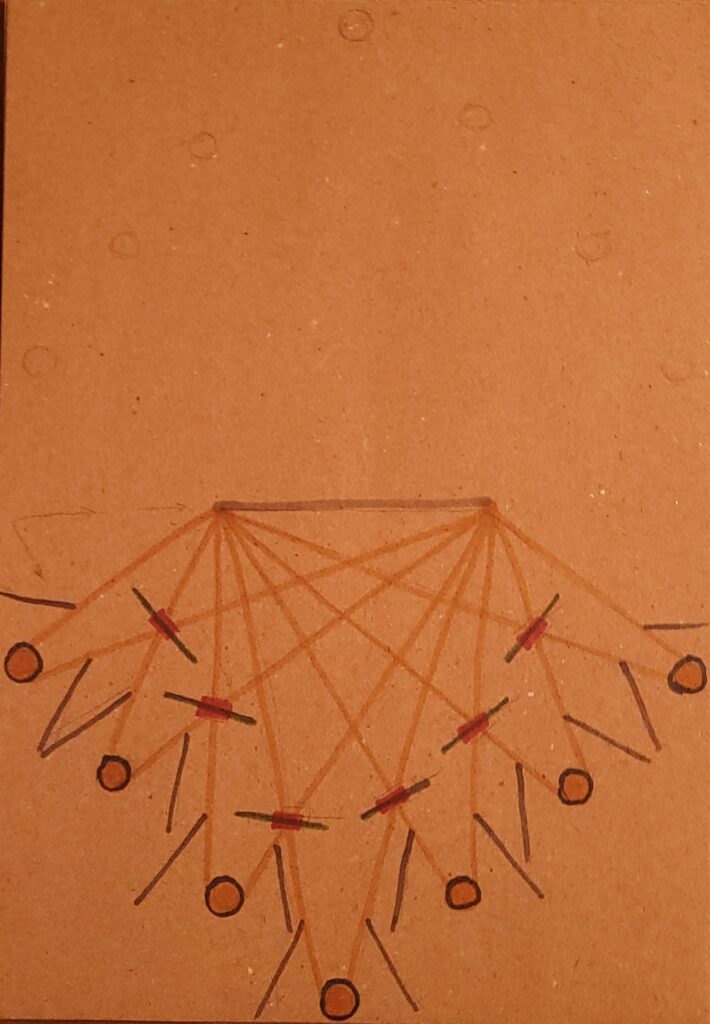
Another suggestion for the distribution of the screens is in drawing number three. In this representation you can see the whole space, with blocks number one and two, which show the path followed by the audience until this point.
First, they enter the space through the tunnel, in the drawing marked as ( 1 ). Then, they follow the walkaway ( 2 ) with the moving screen that hosts the first video ( 4 ). In the end of this walk, the performer appears behind this main screen ( 4 ). After that, still located on the walkaway ( 2 ), participants are guided to their seats (purple circles), and each of them has their own particular screen in front of them ( 3 ). In other words: each participant can see their own holographic screen ( 3 ) and the main screen ( 4 ).
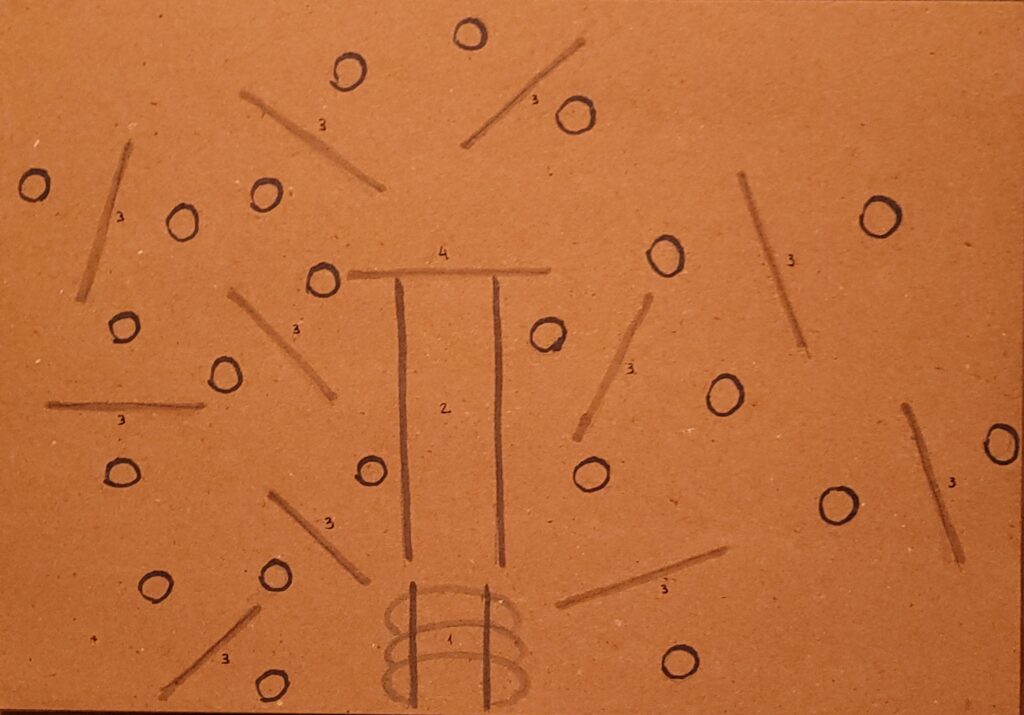
This is the setting where the performance happens. The holograms in front of each audience member shares a narrative through text and performance. From this moment on, the intention is to confirm the questioning that the audience should have until this moment, an experience of using or not touch to investigate the existence or non existence of what is seen. For that, I intend to explicitly mix digital and physical elements, in a way that they are so seamlessly blend, the participants truly believe some digital elements are actually physical.
Block two – absurd familiarity
For the transition between the last and this block, the audience watches two or three scenes that expose the performer’s body in bold, intense movement dramaturgies/small performances, using plastic elements to disguise the performers identity and serve as an expanded body. The first is the the moment when the performer is seen behind the main screen, the second is the audience being guided to their seats, and the third is the use of an hologram instead of the performer itself.
The hologram gives the persona some freedom to act in the boldest possible ways, that wouldn’t be advisable without the digital extension of the person because they could compromise their physical integrity. The movements can be alternated between happening on each of their particular screens, and on the main screen, to be seen by all simultaneously. One movement I imagine to happen on the main screen is an explicit reference to Yves Klein’s The Jump, the performer diving into the abyss of the unknown from the top of the dunes. This should be filmed beforehand, and shown in the space through a projection on a holographic screen. I thought this could maybe mean some sort of cheating as I mentioned above, in the sense of interpreting instead of acting. But the jump would be real. It would have to be filmed in a space where the performer could throw themselves from a high point in the direction of the floor. Even if this space has cushions or something to dampen the damage, the fall is real.
See below an example of a projection on an holographic screen. On the pictures, you can see better that it’s a transparent screen because of the objects behind it, which gives a sense of a 3D person. In the following weeks, I will explore better other ways for the screen to be used. In the video, you can see that it looks like a video of a person moving, when it’s actually a video of a projection of a video. Someone that would be present would have the sensation that they are seeing a person live, when they are actually seeing a projection of a video of a person.
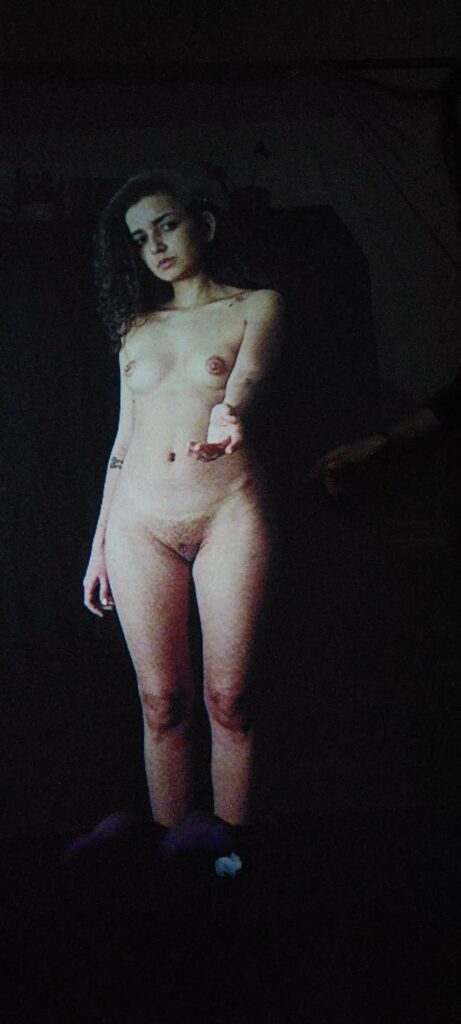
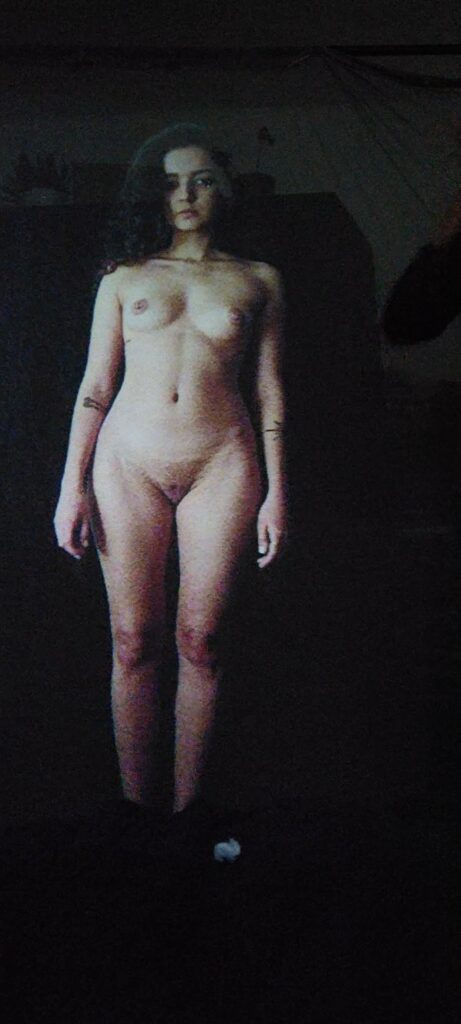
For the last part of this block, the participants will be guided into a more intimate path. The intention is that they feel as much as part of the space as the performer and all the elements present. This part can happen either in the same space, on their particular screens, or in a transitioning space, such as the first corridor. For the sake of the explanation, I will get in detail about the technicality of it assuming it will happen in a transitioning space, even though I am more keen to the other option, and will explain this in detail below.
The space is a spiral looking corridor that has glass walls on one side, and a scenography on the other side. The wall is separated into three blocks of glass. Looking at the first one, the person would see themselves, as in a reflection, through a live and simultaneous video transition of them, being filmed from one side, and being projected on the glass. The scenography behind the screen would be the exact same as the one behind them. On the second glass, the person would see also the same scenography, but the performer that was guiding them until now as well, as if they were also a reflection and were behind them, but they are actually only seen on the reflection. This can be done either by the performer being behind the glass, or another projection of them being made by the side of the audience’s projection. On the same “station”, there comes a moment when the performer’s face is projected on top of the persons’ face (see image as reference). On the last glass, only the scenography is being shown, no projections of reflections.
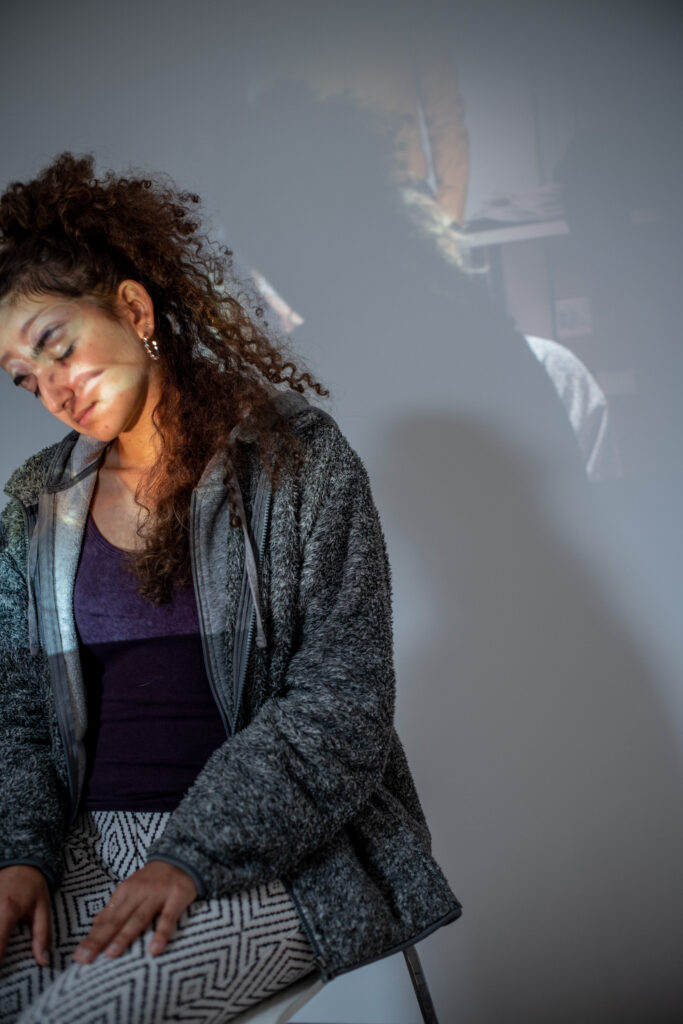
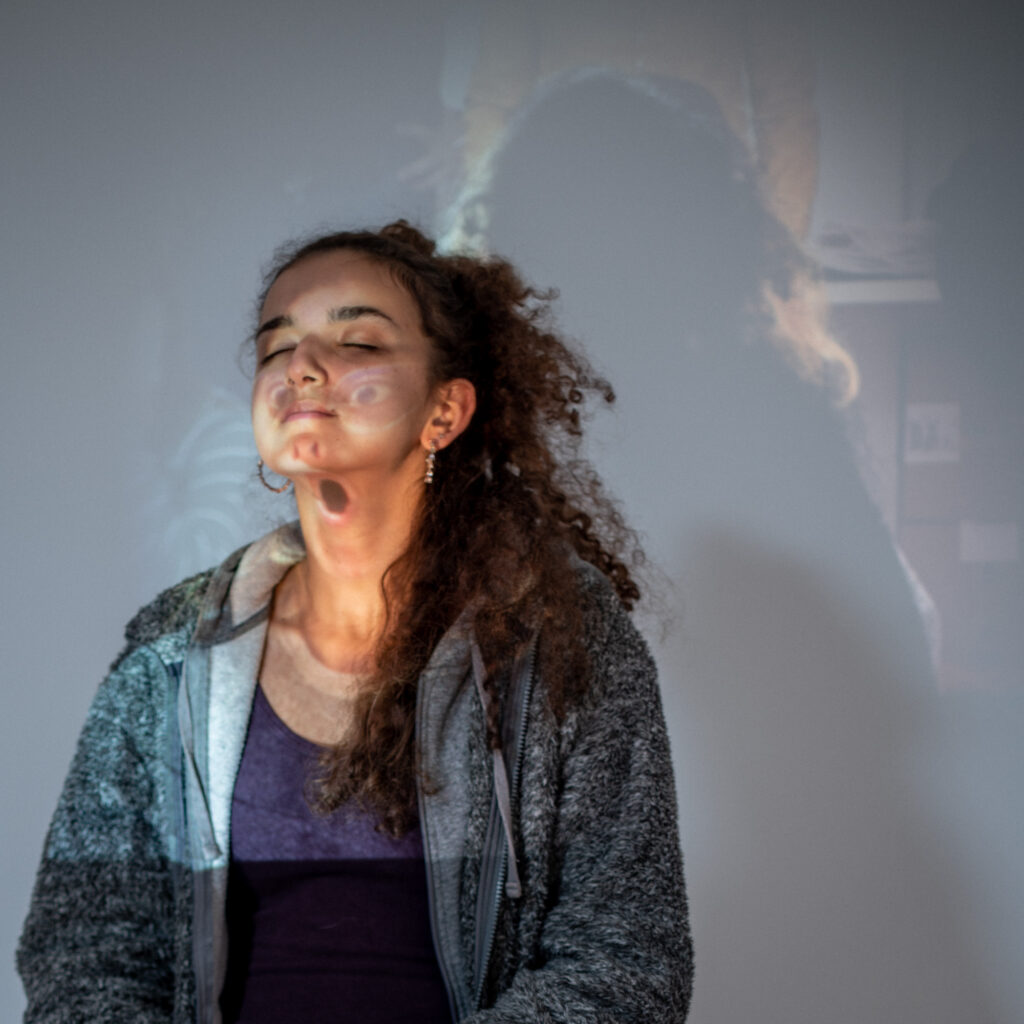

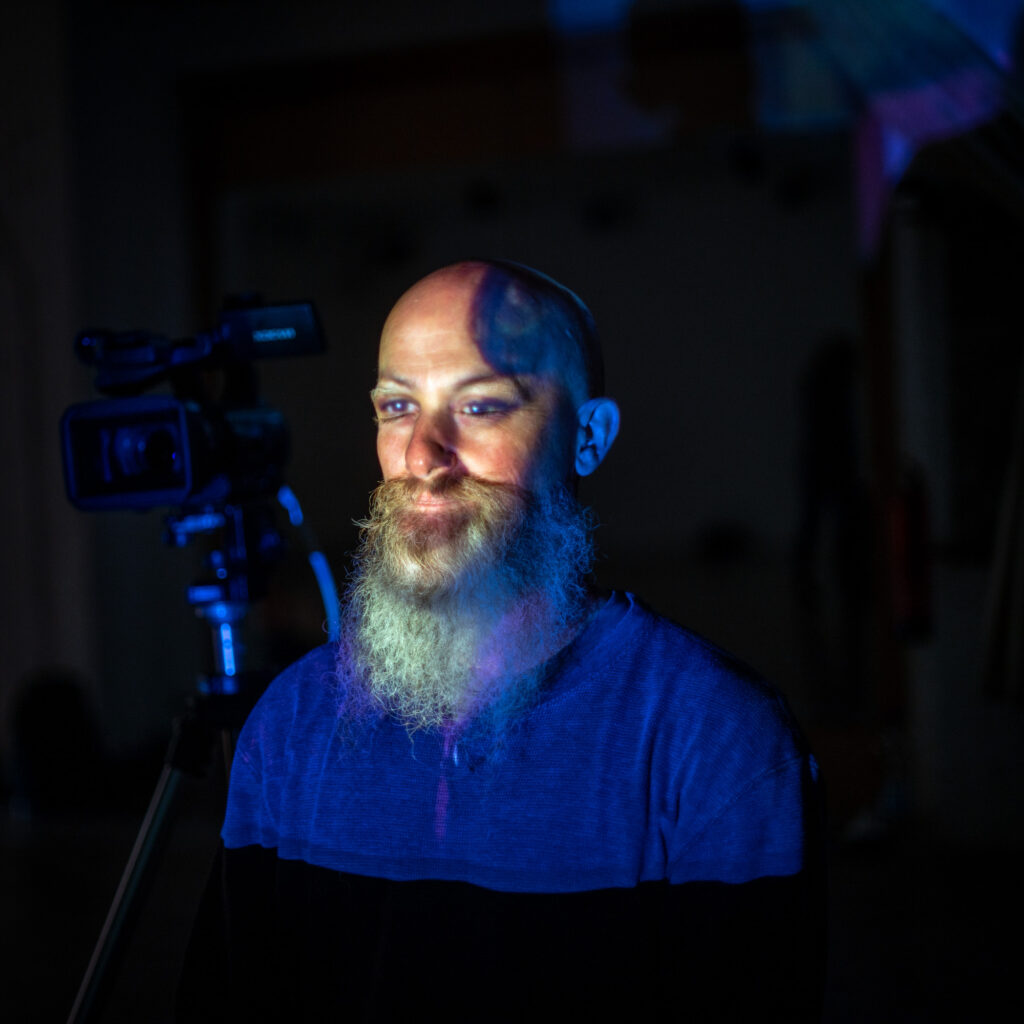


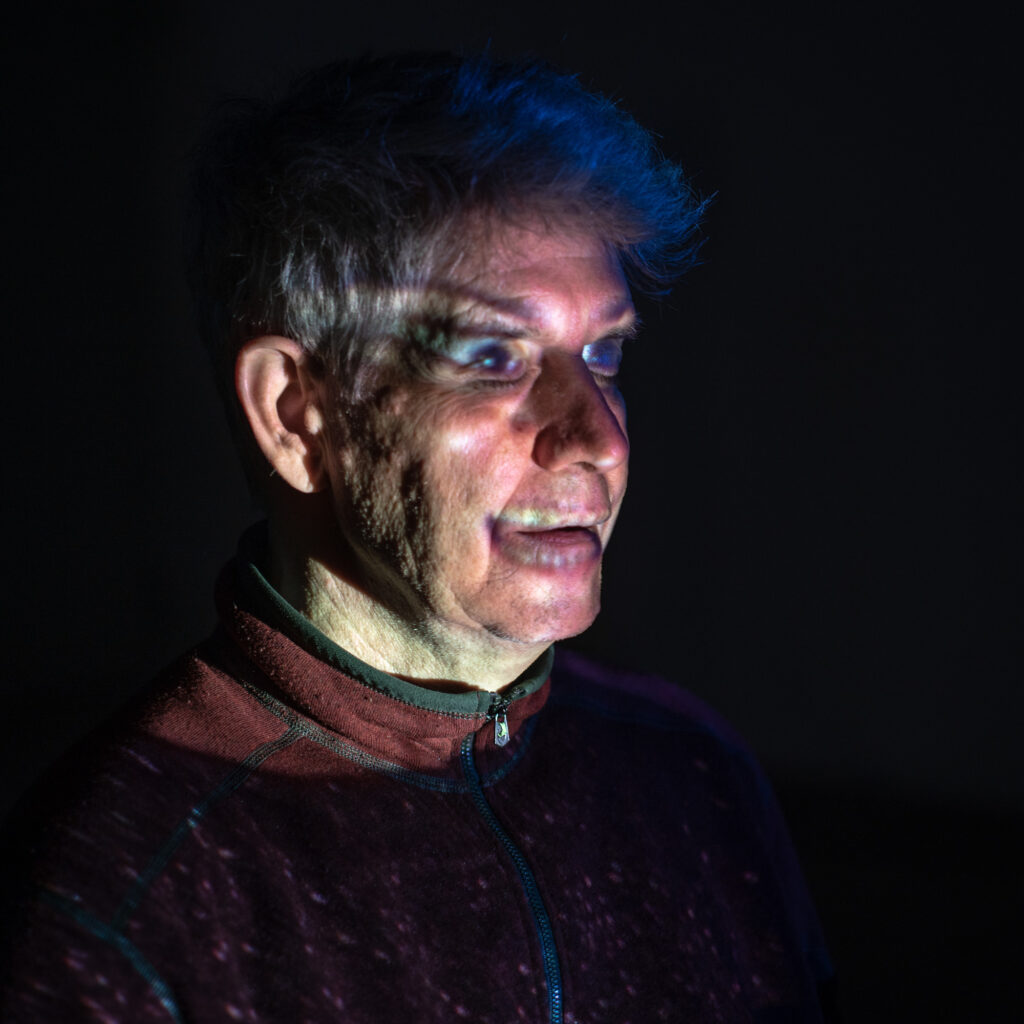

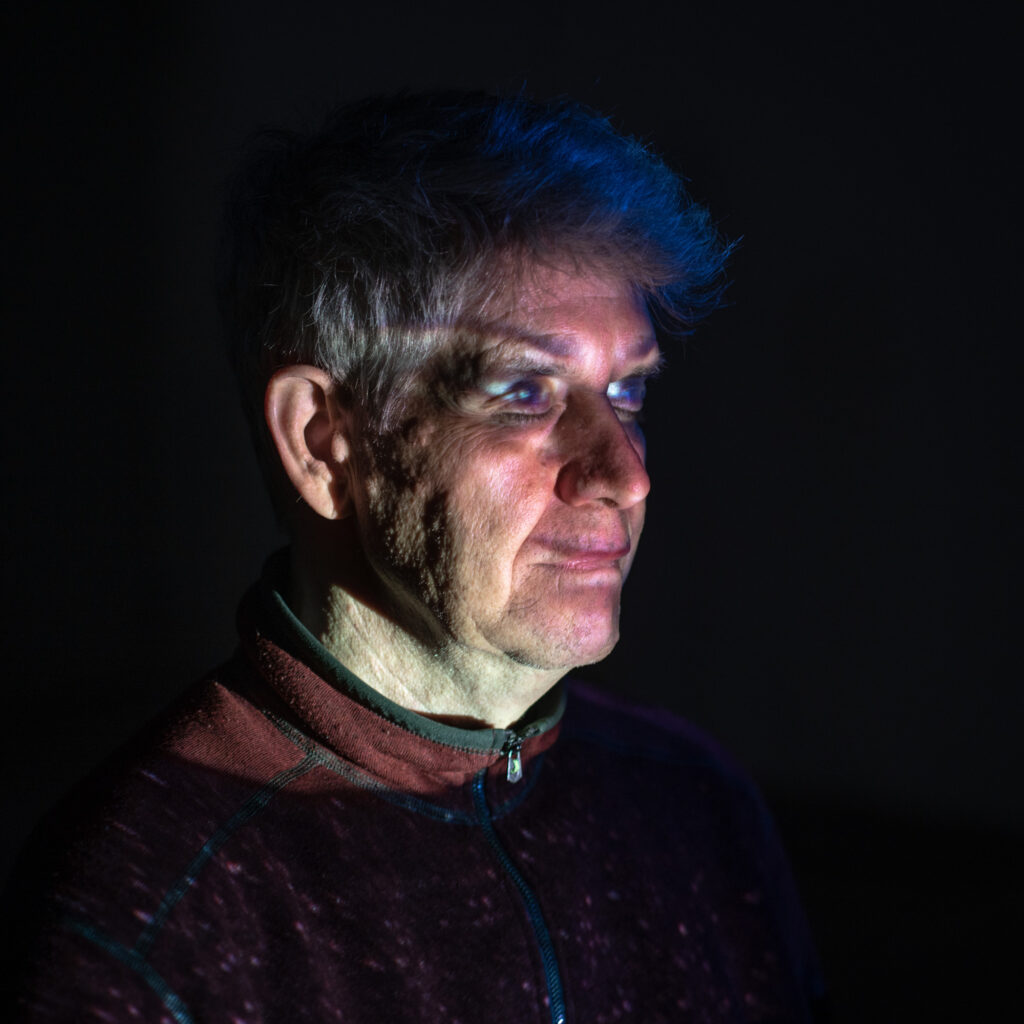
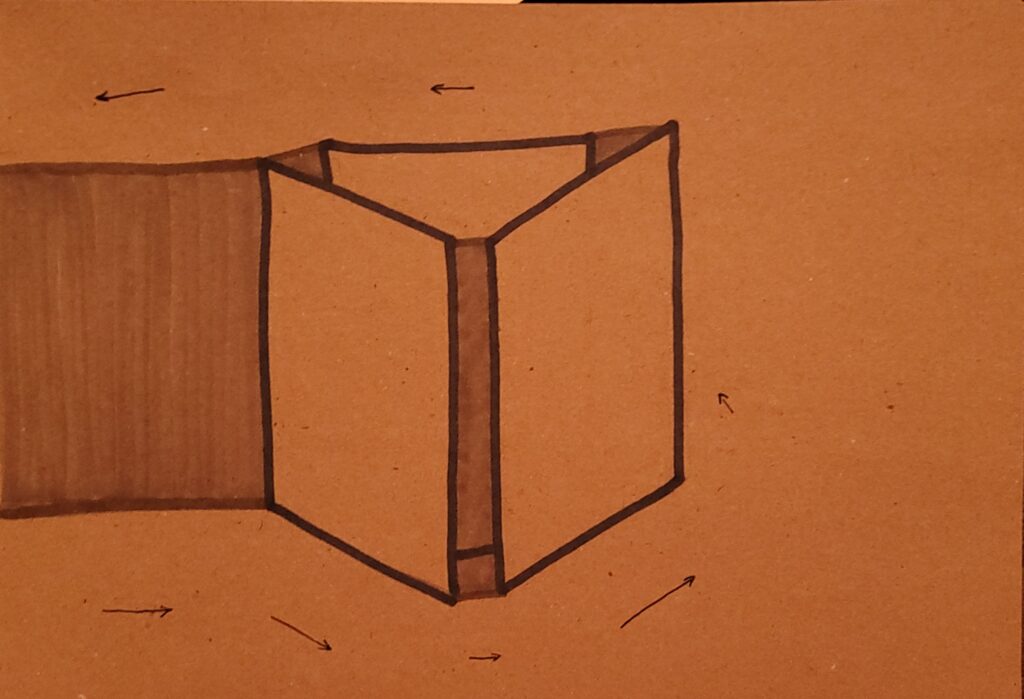
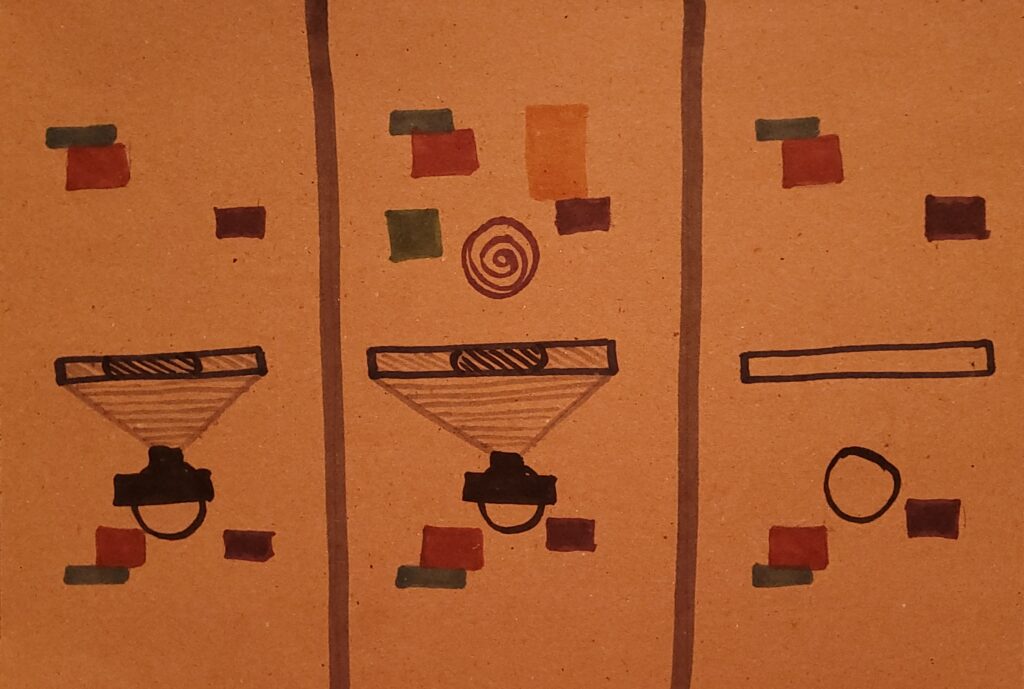

2. Glasses one, two and three with participant in front of them. On glass one, the exact same scenography, and a projector on top of the audience member, projecting their body on the glass. On glass two, the same, plus scenography elements on the inside that are not present on the audience’s side, and a performer. On glass three, just the same scenography, but no projection.
3. Explanation of how to mutually film and project the audience’s body on the glass. On one side of the glass, a camera filming the person. On the other side, a projector simultaneously showing the image that is being recorded.
Block three – the secret
The last block of the performance has two possibilities. One is if the audience is, in the end of the previous block, guided into another space. The other, if the audience stays on the same space, which changes.
First, if the audience was guided into another space: Following the repetition of elements, the audience is then guided into a space that seems like a capsule, with infinite LED mirrors above and beneath them, and walls that keep the repetition of elements. The floor and ceiling give the sensation of a never ending space, and that they are so blent with it that they are now one.
There is a miniature of it inside, like in the representation below. The person is inside this capsule, and being a miniature of the capsule itself there. A camera is on the ceiling, filming as the person observes. When they look inside the miniature, they find a projection of themselves, of the video being transmitted live. Now, they not only feel as part of this space, but also see themselves in this condition. As in many parts of this journey, I imagine it will be necessary to have some sort of audio guidance at this part, to make sure that the person is aware of the inception-like space.
If the audience stays at the same space for the whole experience, this part is substituted by the repetition of elements taking over the whole installation, and projecting on themselves as well. This is a moment of silence and observation, with no text, only increasing sound.
This part was inspired by George Bataille’s book Eroticism. Bataille argues that isolation leads to disconnection from others, which leads to a sense of sexual infinitude, non-life and non-death. A limbo of the senses. He interprets sexual self-realization as an attempt to feel alive and conceive sense of finitude, to generate a complete cycle. It is a self-realization through discrete imagination, and I propose this imagination to happen through explicit rite, which is this performance. I propose a fusion of my body with the poetic body, that briefly diminishes the abyss between the body-self and the body-other, a ritual that tears the constituted self out of my discontinuous order. A return to the animal world for the total destruction of the world of rules.
In his book, he states that the unintelligible and unknown continuity of being is “the secret of eroticism and of which only eroticism has the secret” (BATAILLE, 2013, p. 24). The continuity is in the fusion of bodies. This fusion makes it possible to lessen the gulf, even if only for a short time, between the self and the other. Thus, eroticism is the violence that rips the constituted being out of its discontinuous order. The idea for this part of the space is exactly a point in the movement dramaturgy that gets the audience in touch with this sense of infinitude.
After that, in case the audience is making an itinerary path in the previous scenes, the participants go to the last part of the installation, which is an open, vast space accessible through a big opening with lights coming from the sides of the passage, making reference to a birth, death or transformation. The persons enter this space that has nothing but a subtle repetition of the same elements from the past blocks on the ceiling. The space is dark and the only parts that have light are the elements, and the bottom part of seats that are available throughout the space. There is a background music that is created based on the sound that was played during the whole experience. In case the participants stay in the same space in the previous scenes, it transforms itself with light design. The installation with the screens and dunes is the same, also with the repetition of elements on the ceiling, but they stay seated where they are.
The audience is welcomed to experience visiting virtual spaces through the use of VR, AR or MR. This is the part of the research that inspired me to later think this installation blent with either of those three resources, but this will be explored later. For now, consider that AR will be used in this part.
The audience will be instructed to use an app, previously existing (such as Snapchat, Instagram) or one developed specially for the presentation, in which they see though their screens either portals or big versions of the repetitive elements. When they walk towards these elements, they enter a different space. The elements are exactly the same, visually, but when they enter those spaces the content is different in each. The possibilities alternate between spaces that confirm the sensations suggested during the experience – spaces with content relating to silence, to the Ma, to moments where nothing happens or small happenings, and the extreme opposite we are used to in a daily basis – chaotic traffic images, persons in a hurry, social media loop. The audience doesn’t know which sort of space they are entering before doing it, since in the outside the objects are the same.
Below, see examples of an AR format to access these spaces, and possible contents to be found inside the virtual settings. The contents are here represented in 2D filming, but to be part of the virtual space, they would have to be filmed in 360 degrees. This can be done with a 360 Camera, such as GoPro MAX.

